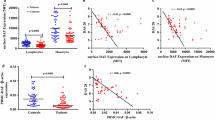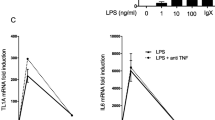Abstract
Latency-associated peptide (LAP) forms small latent complexes with transforming growth factor beta 1 (TGF-β1). TGF-β–LAP complexes can be detected on the surfaces of immune cells and have been recently shown to play a role in immune regulation through TGF-β1-mediated functions. A study was undertaken to investigate the correlation of LAP expression on the surface of immune cells and presence of articular erosions in patients with rheumatoid arthritis (RA). Venous blood was obtained from patients with severe RA as well as from healthy control subjects. Surface expression of LAP on peripheral blood mononuclear cells was analyzed by flow cytometry, measured as flow cytometric intensity separately on CD14+ and CD14− cells, and compared between RA patients and healthy subjects. Patients with RA demonstrated higher surface expression of LAP on both CD14+ and CD14− mononuclear cells than healthy individuals. Patients with erosive RA had significantly reduced intensity of anti-LAP staining on the CD14+ cells when compared to RA patients without erosions (p = 0.01). The intensity of anti-LAP staining on CD14− cells was not different between groups of RA patients. Higher expression of LAP on the surface of the cells of monocyte lineage may be protective of formation of articular erosions in RA. Further studies are needed to elaborate the mechanism of this phenomenon.



Similar content being viewed by others
References
Janssens, K., P. ten Dijke, S. Janssens, and W. van Hul. 2005. Transforming growth factor-β1 to the bone. Endocrine Reviews 26: 743–774.
Ghandi, R., D.E. Anderson, and H.L. Weiner. 2007. Cutting edge: immature human dendritic cells express latency-associated peptide and inhibit T cell activation in a TGF-beta-dependent manner. Journal of Immunology 178: 4017–4021.
Ghandi, R., M.F. Farez, Y. Wang, D. Kozoriz, F.J. Quintana, and H.L. Weiner. 2010. Cutting edge: human latency-associated peptide+ T cells: a novel regulatory T cell subset. Journal of Immunology 184: 4620–4624.
Slobodin, G., A. Kessel, I. Kuznets, R. Peri, T. Haj, I. Rosner, et al. 2012. CD14brightLAP+ mononuclear cells in peripheral blood positively correlate with BASRI scores in patients with ankylosing spondylitis: a pilot study. Joint, Bone, Spine 79: 633–634.
Chu, C.Q., M. Field, S. Allard, E. Abney, M. Feldmann, and R.N. Maini. 1992. Detection of cytokines at the cartilage/pannus junction in patients with rheumatoid arthritis: implications for the role of cytokines in cartilage destruction and repair. British Journal of Rheumatology 31: 653–661.
Mattey, D.L., N. Nixon, P.T. Dawes, and J. Kerr. 2005. Association of polymorphism in the transforming growth factor β1 gene with disease outcome and mortality in rheumatoid arthritis. Annals of the Rheumatic Diseases 64: 1190–1194.
Ceccarelli, F., C. Perricone, M. Fabris, C. Alessandri, A. Iagnocco, C. Fabro, et al. 2011. Transforming growth factor β 869C/T and interleukin 6-174G/C polymorphisms relate to the severity and progression of bone-erosive damage detected by ultrasound in rheumatoid arthritis. Arthritis Research & Therapy 13: R111.
Drynda, S., C. Kuhne, and J. Kekow. 2002. Soluble tumor necrosis factor necrosis treatment does not affect raised transforming growth factor beta levels in rheumatoid arthritis. Annals of the Rheumatic Diseases 61: 254–256.
Pohlers, D., A. Beyer, D. Koczan, T. Wilhelm, H.-J. Thiesen, and R.W. Kinne. 2007. Constitutive upregulation of the transforming growth factor β pathway in rheumatoid arthritis synovial fibroblasts. Arthritis Research & Therapy 9: R59.
Ehrenstein, M.R., J.G. Evans, A. Singh, S. Moore, G. Warnes, D. Isenberg, and C. Mauri. 2004. Compromised function of regulatory T cells in rheumatoid arthritis and reversal by anti-TNF-α therapy. The Journal of Experimental Medicine 200: 277–285.
Zamvil, Scott. 2012. Regulatory monocytes in CNS autoimmune disease. http://www.labome.org/grant/r01/ns/regulatory/monocytes/regulatory-monocytes-in-cns-autoimmune-disease-7876658.html
Haiyan, L., S. Hong, J. Qian, Y. Zheng, J. Yang, and Q. Yi. 2010. Cross talk between the bone and immune systems: osteoclasts function as antigen-presenting cells and activate CD4+ and CD8+ T cells. Blood 116: 210–217.
Conflict of interest
None.
Author information
Authors and Affiliations
Corresponding author
Rights and permissions
About this article
Cite this article
Slobodin, G., Kaly, L., Peri, R. et al. Higher Expression of Latency-Associated Peptide on the Surface of Peripheral Blood Monocytes in Patients with Rheumatoid Arthritis may be Protective Against Articular Erosions. Inflammation 36, 1075–1078 (2013). https://doi.org/10.1007/s10753-013-9639-6
Published:
Issue Date:
DOI: https://doi.org/10.1007/s10753-013-9639-6




